
Home to the most fantastic wilderness scenery, it’s not surprising the Canadian Rockies are a top tourist destination. Banff is home to turquoise lakes, jaw-dropping glacial mountains, and an abundance of diverse wildlife. The scenery attracts busloads of people each year.
Whether you come to enjoy camping in Jasper and Banff or experience the outdoors on one of its hikes, you’ll be forever touched by its landscape.
Beyond the mountainous vistas, take time to explore the incredible lakes in Banff National Park. Some are a drive to, while hiking accesses others.
When I think of the Rocky Mountains, camping, hiking, and landscape photography come to mind. Living in Vancouver, the mountains are a short drive away and a place I often visit. Whichever you choose to visit, these are the finest you will see anywhere in the world.
I have been to Banff countless times and still remember the first time. Its beauty left me utterly speechless, and I am thankful I live pretty close to this fantastic place.
The Icefields Parkway is a mountainous roadway running through Banff and Jasper National Parks. It provides access to these incredible lakes on a journey considered one of the world’s best drives.
For a reference point, where the Trans Canada Hwy meets the Icefields Parkway, this is the Junction. All mileage markers are from the Trans Canada Hwy junction.
Peyto Lake
- Location: 40 km (24.8 miles) north of the Junction
For many, Peyto Lake is one of the most iconic lakes in Banff National Park. If you haven’t seen it, the stunning lake is a beautiful shade of turquoise, seen all over the web.
The lake also boasts an unusual shape (which looks like a wolf?) that is very memorable to every visitor.
Peyto Lake, Banff, is one of the most accessible lakes to view, seeing that the viewpoint is close to the Icefields Parkway.
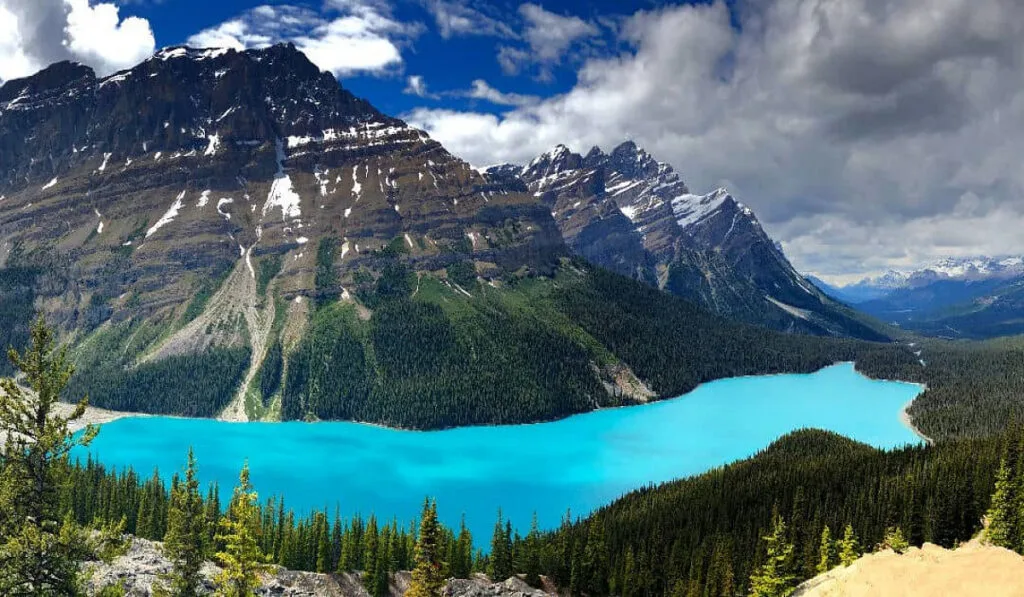
The lake is glacier-fed, and its iridescent color comes from large amounts of glacier rock flour that flows into it during the summer.
Large crowds from buses occupy the Peyto Lake lookout at this picture-postcard lake during the busy warmer months. As you make your way to the viewing platform, there is a small trail to the right.
Follow this trail a short distance to an open area with unobstructed views in the distance.
While the viewpoint has no fencing with sharp drop-offs, it is void of tourists. Once you’ve seen this iconic lake, you’ll agree that you’ve seen the best of Banff.
If you prefer a closer look at this fantastic lake, there is a Peyto Lake trail to the water’s edge. While the trail is steep, Peyto Lake’s shoreline was void of people and well worth the hike.
If you plan to take the Peyto Lake hike, ensure you have good hiking boots that provide ankle support.
The parking lot and viewpoint recently underwent an upgrade, and the new wooden platform offers terrific views of the valley.
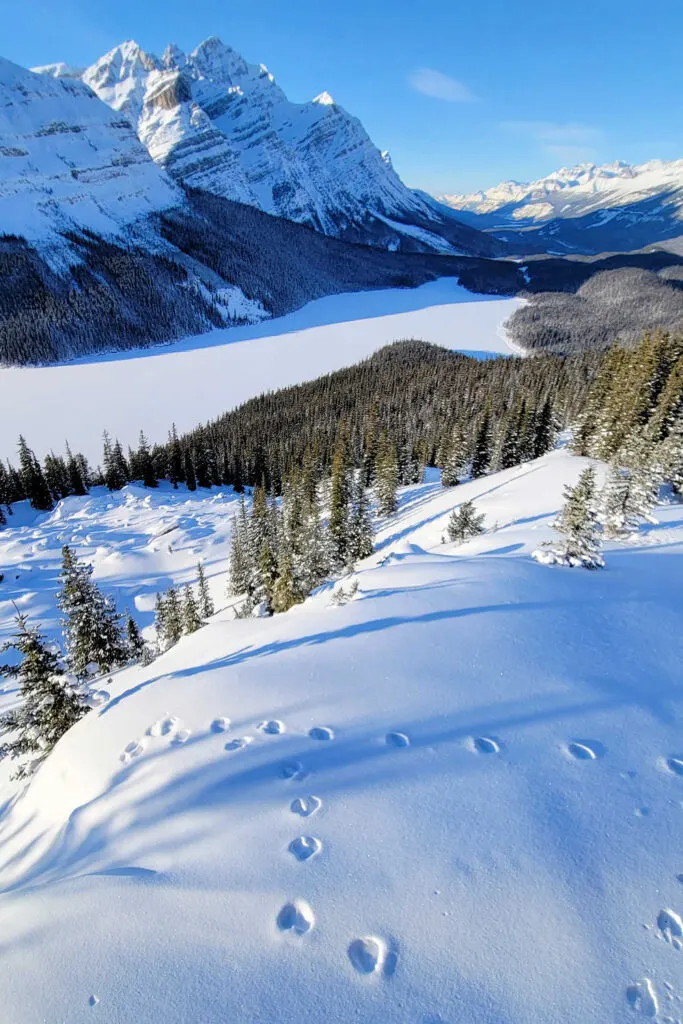
If you visit Peyto Lake in the winter months, its landscape is equally picturesque. Since Bow Summit is the highest point on the Icefields Parkway, it receives significant snowfall.
Dress warmly as temperatures fall to -30C with four feet of snow. Theirs is no access to the lake in winter due to avalanche risk.
Bow Lake
- Location: 34 km (21.1 miles) north of the junction
With a backdrop of majestic mountains and Crowfoot Glacier, it’s hard not to capture a stunning picture of Bow Lake. While most stop at the parking lot for quick photos of the lake, it’s best to venture beyond your vehicle.
The shoreline views are superb and if you’re up for a hike, take the leisurely trail to Bow Glacier Falls. The 9 km hike is accessible in summer and winter and starts from the Num-Ti-Jah Lodge.
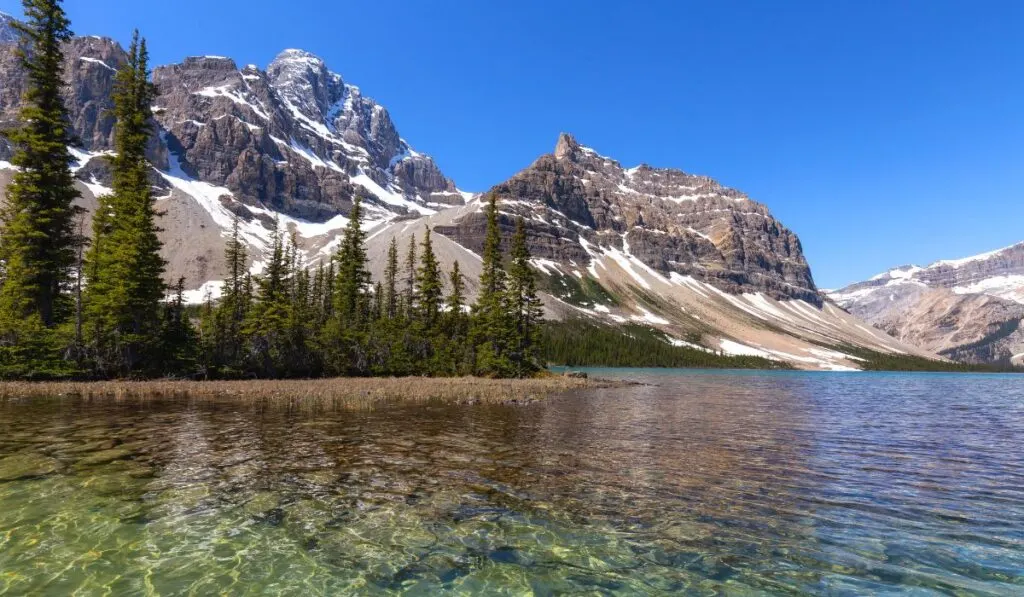
Being one of the larger lakes in Banff, this is a place you need to experience. The best time to visit is in June, when the wildflowers are prevalent.
The mirror-like lake offers spectacular reflections of the mountainous scenery if the day is calm. With crowds gathered at the more popular Peyto Lake and Lake Louise, you can be one with nature and enjoy the serenity of your surroundings.
In winter, Bow Lake is popular amongst locals as the frozen waters provide great snowshoeing and cross-country skiing. While the turquoise hues of the water are not viewable, the images are still captivating with the snow-capped mountains.
If you want to savor the Bow Valley longer, Num-Ti-Ja Lodge, situated on Bow Lake, is the perfect place to stay.
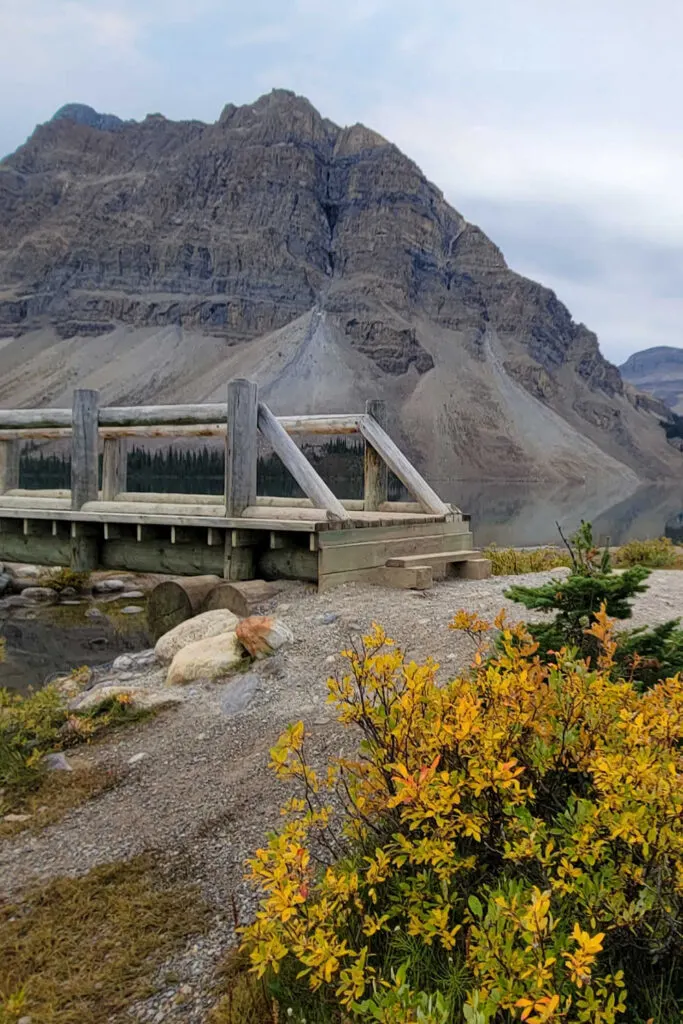
September is another great time to visit. In the autumn, the vegetation around the lake turns to shades of yellow, orange, and red. You might even witness the haunting calls of elk during rutting season.
Lake Louise
- Location: 2 km (1.2 miles) west of the Junction
Lake Louise is the most famous of all lakes in Banff National Park, with its first-class Chateau, picturesque views of the mountains, and Victoria Glacier. If you visit this lake in June, it may have just finished its winter thaw, so don’t expect those turquoise hues.
Regardless of when you visit, plan to spend a day there because there are plenty of things to do around Lake Louise, both in summer and winter.
The waters at this lake are generally turquoise in color, while the mountains and glaciers provide a stunning backdrop for avid photographers. Mornings are best because by afternoon, the sunlight casts a shadow on the lake.
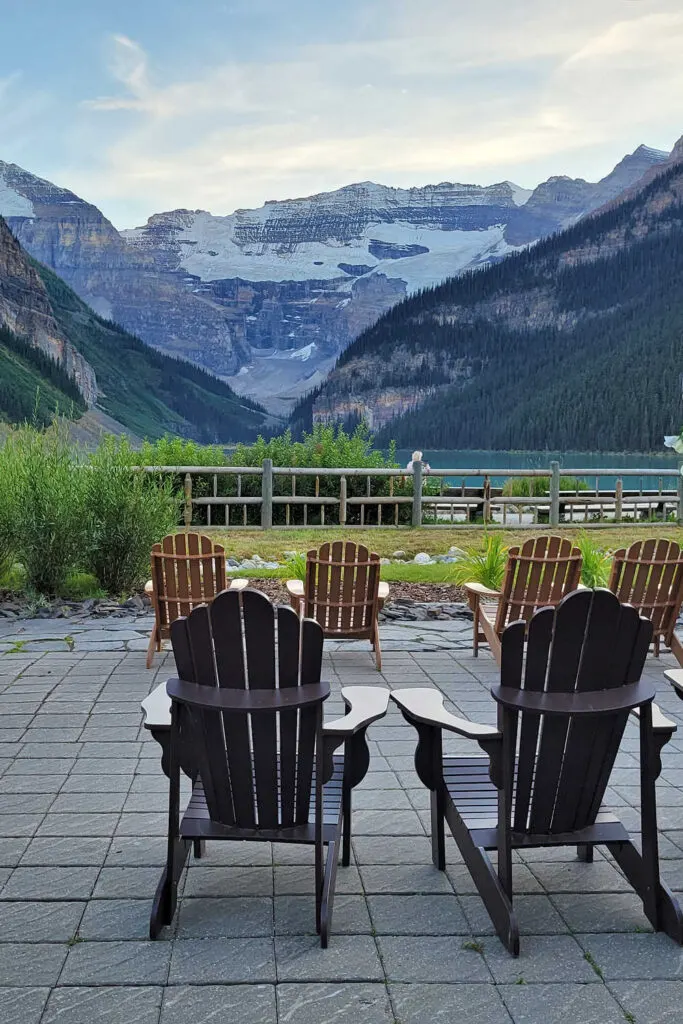
If you want to wake up to this gorgeous pristine lake every morning, consider a stay at the stately Fairmont Chateau Lake Louise.
There is an array of Lake Louise hikes to satisfy every level of hiker. The lakeshore trail offers a pleasant stroll to the lake’s head, where glacier water streams down from the mountain.
For adventurous visitors, take the uphill hike to the little and big Beehives. While the walk is relatively challenging because it’s all uphill, the most spectacular views imaginable reward the hiker after the climb.
I did this hike with two small children. If we could do it, you can too! On the way down, struggling hikers were inspired by my small children, who had finished the climb.

If you’re not a hiker and want to know what to do in Lake Louise? Why not rent a canoe on the lake? Canoeing is a relaxing activity that allows you to escape the crowds between the Chateau and the lake.
A quiet outing on this spectacular lake will enable you to capture its magnificence in your mind forever.
Consider the Lake Louise gondola if you want an aerial view of the lake and the surrounding area. As a bonus, gondola riders often spot grizzly bears in their natural habitat.
Yoho National Park, close to the Lake Louise area offers more picturesque lakes. Why not consider a day trip and hike to Lake O’Hara or Emerald Lake?
Lake Louise is a year-round destination with its luxury Chateau. If you visit Lake Louise when there’s snow, you won’t see the turquoise hues of the water because it’s frozen. However, you’ll enjoy wintery activities such as ice skating, dog sledding, sleigh rides, and snowshoeing.
Lake Agnes
- Location: 6 km (3.7 miles) west of the junction
Lake Agnes is the smallest lake on this list and requires a challenging hike to see it. Access to the mountainous trail starts at the Fairmont Chateau Hotel.
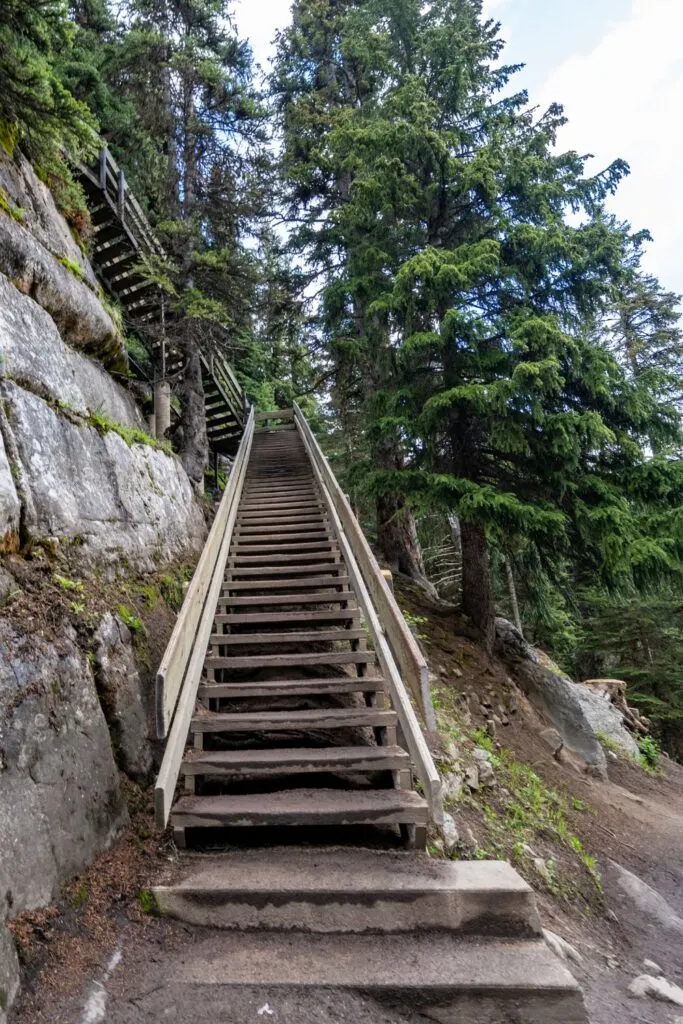
The 3.5 km uphill hike is not for the faint of heart as it ascends on switchbacks with few rewarding views of the glacial lake. The lake sits in a hanging valley and doesn’t thaw until sometime in June.
Only once you’ve cleared the trees will you have fantastic views of the valley. Remember to bring some money as the climb’s reward is lunch or a snack at the teahouse.
Buy a hot cup of tea and find a spot amongst the crowd to enjoy the stunning vistas. While the teahouse might be in a remote location, it boasts of having over 100 tea varieties.
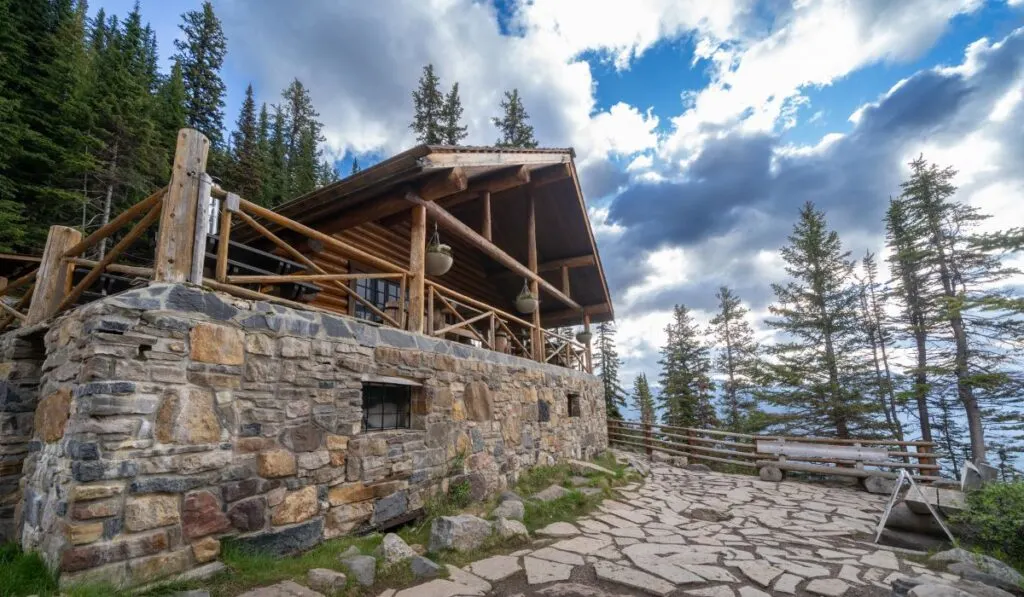
While the prices are high, you need to bear in mind that all supplies are brought up the mountain by the staff who do the climb. Their sandwiches are made from homemade Oatmeal Brown Bread, baked daily.
After a much-needed break, consider extending your hike to one of the beehives or further west to the Plain of the Six Glaciers. The trails in this area offer some of the best hikes in Banff National Park.
Although most visit the Rocky Mountains in the summer months, Lake Agnes is accessible year-round, but you’ll need to check for the avalanche risk before you go.
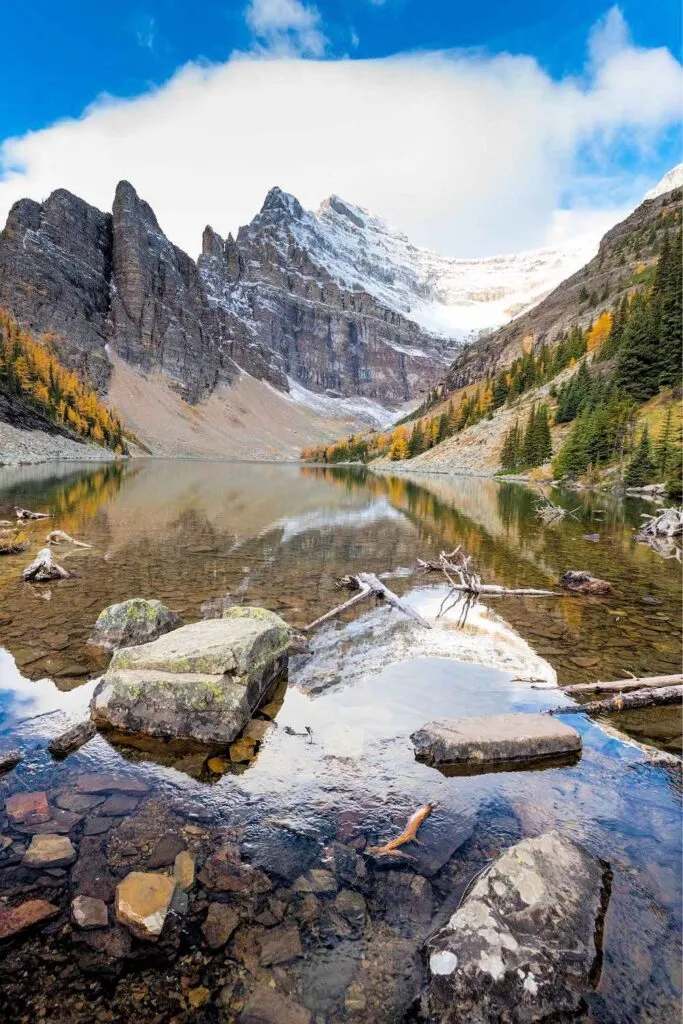
While snow blankets the trail in winter, it’s a popular snowshoeing destination in the off-season.
Moraine Lake
- Location: 16 km (9.9 miles) west of the junction
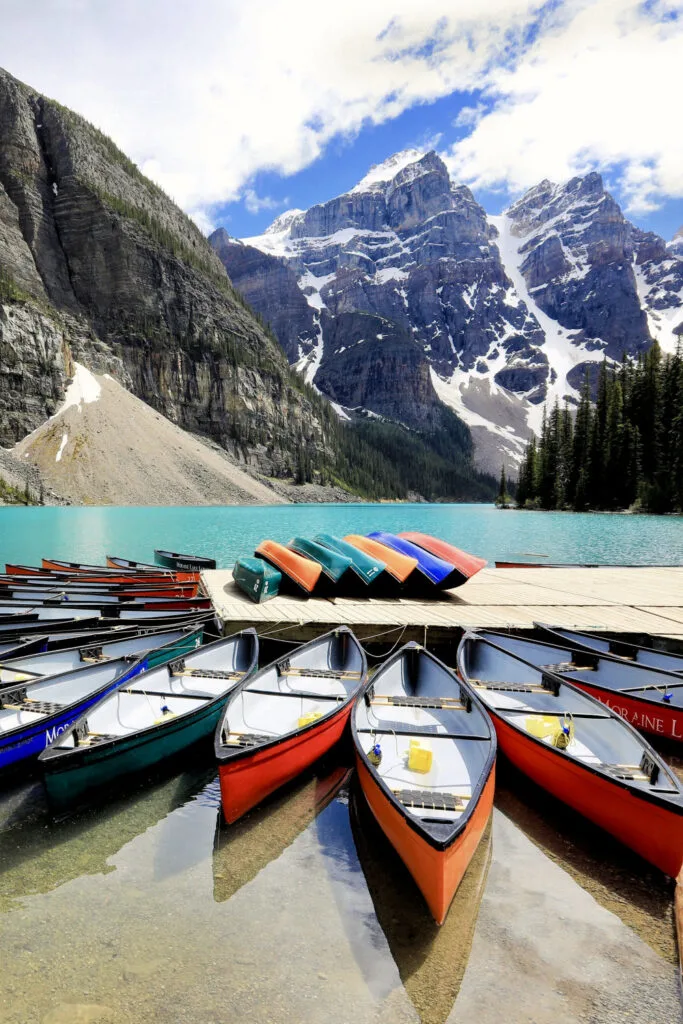
No visit to Banff National Park is complete without a visit to Moraine Lake. Set in the rugged Valley of the Ten Peaks southeast of Lake Louise, Moraine Lake is even more stunning than the latter and one of the most popular Banff attractions.
Moraine Lake is glacier-fed like Lake Louise, giving it its gorgeous blue-green color. Since this lake is near Lake Louise, it’s best to visit both on the same day.
Getting to Moraine Lake has been problematic as the road to access it has been closed to private vehicles. Now visitors needs to book a shuttle. Moraine Lake Bus Company offers 5 daily shuttles, sunrise departures, and beats the hassle of trying to book with Parks Canada.
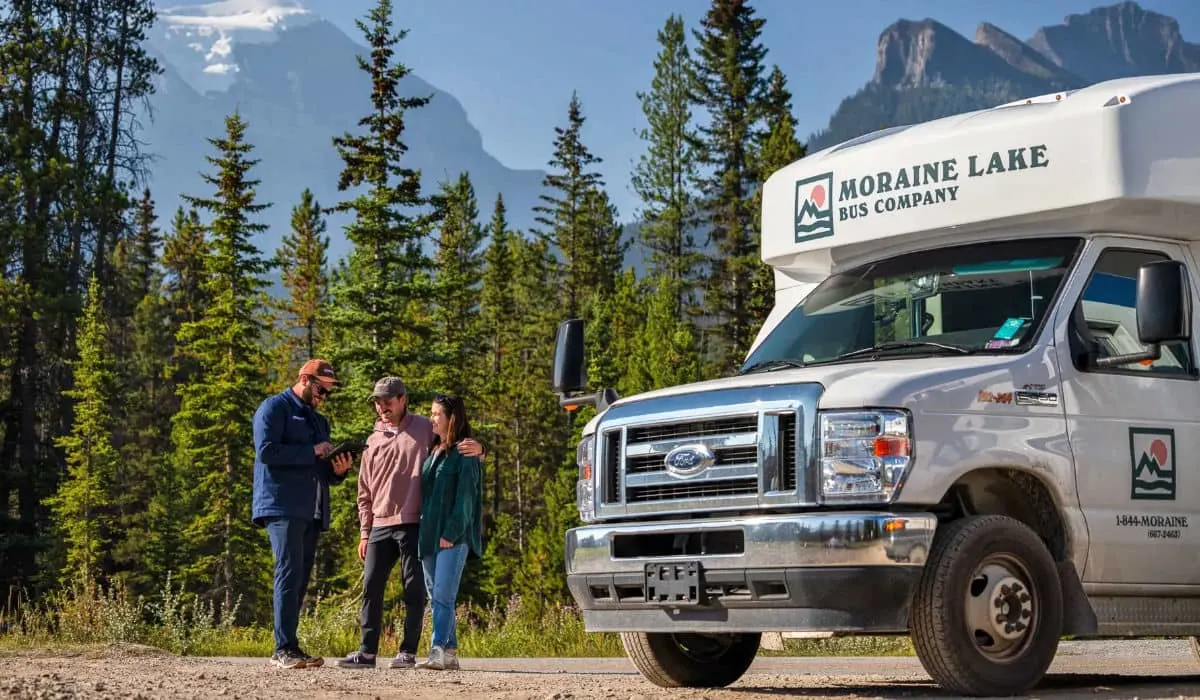
The lake’s best views are from the top of the moraine, at the end of a short switch-back trail from the parking lot. Be on the lookout for wildlife.
The rocky moraine is a haven for chipmunks, pika, and hoary marmots who love to lay out in the sun. Trails in the area are plentiful for both easy and advanced hikers.
Although half the size of Lake Louise, Moraine Lake is renowned for being on the Canadian $20 bill.
Like Lake Louise, Moraine Lake has a shoreline trail to the head of the lake. The path is reasonably flat and allows for an easy hike away from the crowds.
Canoe rentals are again possible, but be prepared to pay more than CAD 100 for an hour on this picturesque body of water.
Unlike Lake Louise, Moraine Lake is only accessible in summer, usually between June and mid-October.
Vermilion Lakes
- Location: 56 km (34.8 miles) southeast of the junction
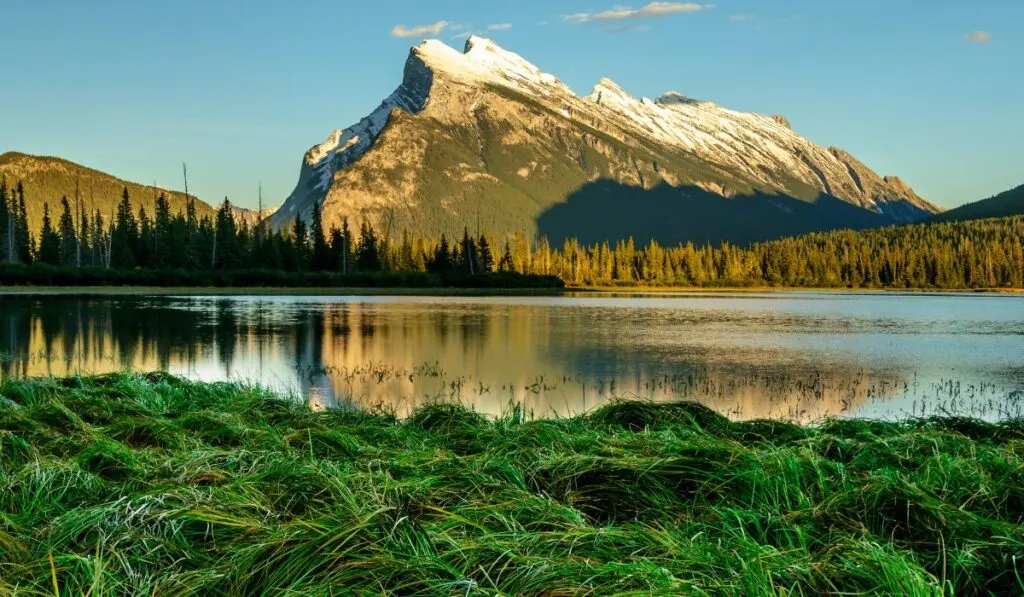
Most people who visit the Rockies tend to pass up these lakes in Banff National Park in favor of more renowned ones like Moraine Lake and Lake Louise. But this is a big mistake because the views across the water to Mount Rundle are indescribable.
Three separate lakes make up the Vermilion Lakes, 2.4 km from the town of Banff. While they don’t have the fantastic turquoise hues of Peyto or Moraine Lakes, they are beautiful in their own way. The Lakes are located between the Trans-Canada Highway and the CP Railway lines.
The edges of the lakes house a network of lush marshlands populated by birds. In the colder months, the lakes attract elk, deer, moose, and the occasional bear. If you visit Banff in the winter, you can enjoy snowkiting on the frozen lakes.
If you plan to visit Banff, consider seeing Vermillion Lakes by bike. Bike rentals are popular, and it eliminates the need for parking. Since parking is problematic, you can get parking at the train station, cross the road and walk to Vermilion Lakes.
In summer, you can enjoy the lakes in a canoe or stand-up paddleboarding. If you have time, consider taking one of the Banff hiking trails around these lakes.
The park has removed some of its parking and replaced it with lakeside benches. So, grab a picnic lunch or a snack, and enjoy a peaceful afternoon at the lake.
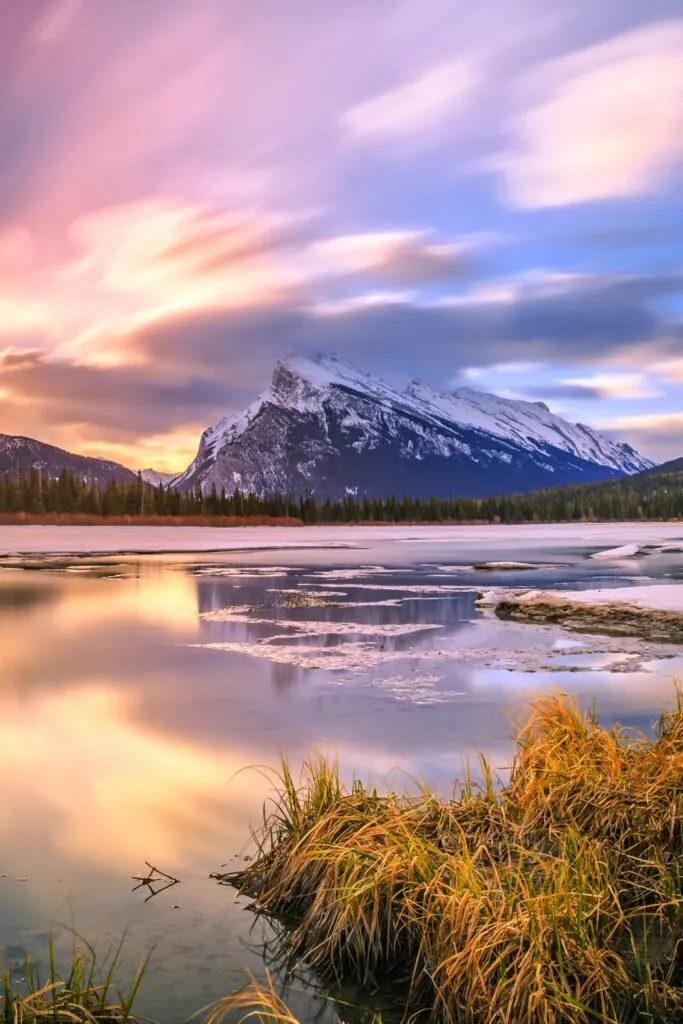
Vermilion Lakes is a great place to capture a photo of Mount Rundle, with sunrise and sunset being the optimum times. The winds are low in the evening, and the water becomes still, making for a mirror-like surface.
Johnson Lake
- Location: 65 km (40.4 miles) southeast of the junction
Located close to Banff, the waterhole provides a popular spot for picnics and water activities in the summer.
Sheltered by the surrounding mountains, the waters are often calmer, making it ideal for paddling and swimming, should you be brave enough to test the cold waters.
If you plan to go out on the water with a stand-up paddleboard (SUP), use a life vest because the water is frigid. There is a hose to rinse off your board when you’re done.

The lake has a decent-sized parking lot which fills up fast on weekends. Plan to arrive early to secure a parking spot. Alternatively, you can catch the Roam bus to avoid the parking problem.
A 3 km (1.8 miles) loop trail follows the shoreline and offers excellent Lake and Castle Mountain views. It’s one of the best hikes for families and those with little hiking experience.
To the east, you’ll also enjoy the towering mountain peaks of Mt. Girouard, Mt. Inglismaldie, and Mt. Peechee.
The lake has lots of picnic tables, spot it’s the ideal spot for families to have a leisurely afternoon.
During the winter months, this smaller lake freezes allowing locals to ice-skate. The shoreline trail then turns from a hiking path to a cross-country ski and snowshoe circuit.
Lake Minnewanka
- Location: 70 km (43.5 miles) southeast of the junction
Lake Minnewanka is Banff National Park’s largest lake and is more commercialized than Johnson Lake. The glacial lake measures 13 miles long, and it’s a busy hub in the summer months since it’s the only lake that allows the use of powerboats.
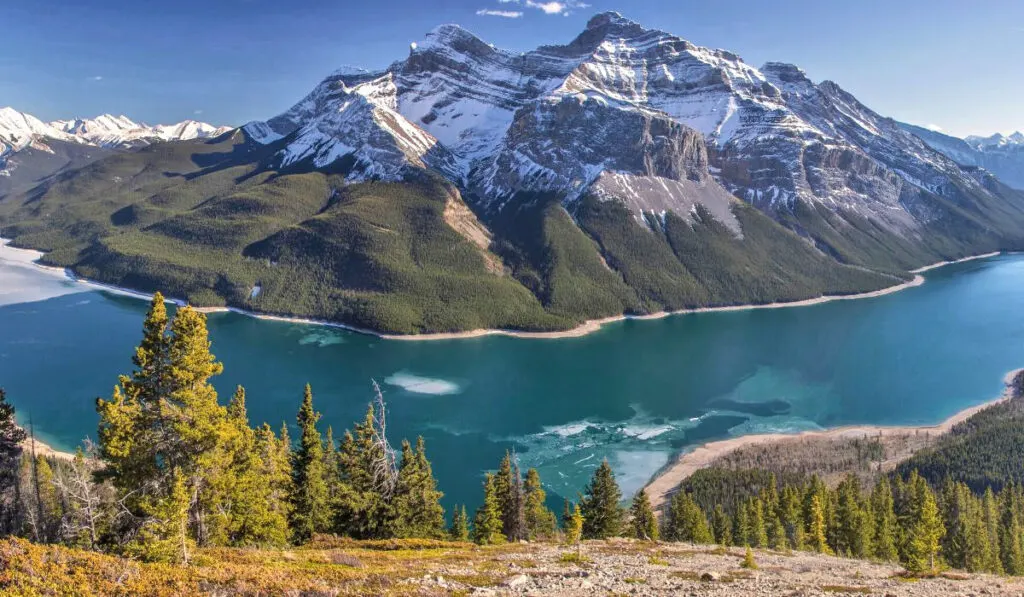
The lake has two large complimentary parking lots, one for vehicles and the other for RVs. Many people travel to Lake Minnewanka to take a scenic cruise. The one-hour tour sells out, so get your tickets in advance.
Anglers flock to Lake Minnewanka for its abundance of whitefish and trophy-sized trout. You can even rent a boat if you want to avoid fishing from the shoreside.
The large lake area offers visitors various Banff activities: hiking trails, mountain biking, picnicking, boating, fishing, and even scuba diving.
Hikes include Lake Minnewanka, Alymer Lookout, Stewart Canyon, and C Level Cirque. If you plan to hike, bring a camera. Big Horn sheep, deer, bears, and eagles roam the area around the lake.
The lake has a rich history going back over 100 years when the early people camped and hunted there. In the Stoney Indian language, it means “Lake of the Spirits” because natives believed spirits inhabited it.

In the winter, you can enjoy wild skating on the lake. Due to its size, it freezes for skating later than other nearby lakes.
Two Jack Lake
- Location: 69 km (43 miles) southeast of the Junction
Two Jack Lake was named after two Jacks; Jack Watters, a Bankhead miner, and Jack Stanley, who offered boat tours on Lake Minnewanka.
Close to Lake Minnewanka, Two Jack Lake offers a more intimate location with lakeside camping. The Two Jack Lake Campground can accommodate small RVs and tents, and with a 15-minute drive to Banff, you’ll have easy access to shopping, groceries, and necessities.

For those without camping gear, the site offers ten oTENTiks, but reservations are required. The campsite has flush toilets, kitchen shelters, hot showers, and fire pits. Like its surrounding lakes, you can access the area on a Roam bus if you don’t have a car.
The lake has emerald-green waters; although glacier fed, you can swim there. Although it lacks the visual watercolor of Moraine Lake, with Mount Rundle as a backdrop, it’s an ideal place to capture a sunrise shot.
Two Jack Lake doesn’t offer any rentals, so it’s less utilized than its neighbors. However, you’ll enjoy the waters with fewer people if you have your own kayak or stand-up paddleboard.
Herbert Lake
- Location: 2.7 km (1.7 miles) north of the Junction
Most travelers don’t purposely visit Herbert. Instead, they make it a stop when traveling up or down the Icefields Parkway.

When traveling north, the parking area to Herbert Lake will be the first stop after leaving the Trans-Canada Highway to join Highway 93.
The glacial lake is small; for many, it doesn’t have the same appeal as giants like Lake Louise and Moraine Lake.
However, if you visit early in the day, you’ll enjoy a mirror reflection of Mount Templeton and a peacefulness not achievable as the busier bodies of water.
Due to the lake’s size, the water is warmer. So, if you’re eager to swim, this might be the lake to choose.
Consolation Lakes
- Location: 16 km (9.9 miles) west of the junction
You’ll need to spend a few hours hiking to see the two Consolation Lakes. The Consolation Lake hiking trail starts at Moraine Lake rock pile and travels around the Tower of Babel to two beautiful lakes.
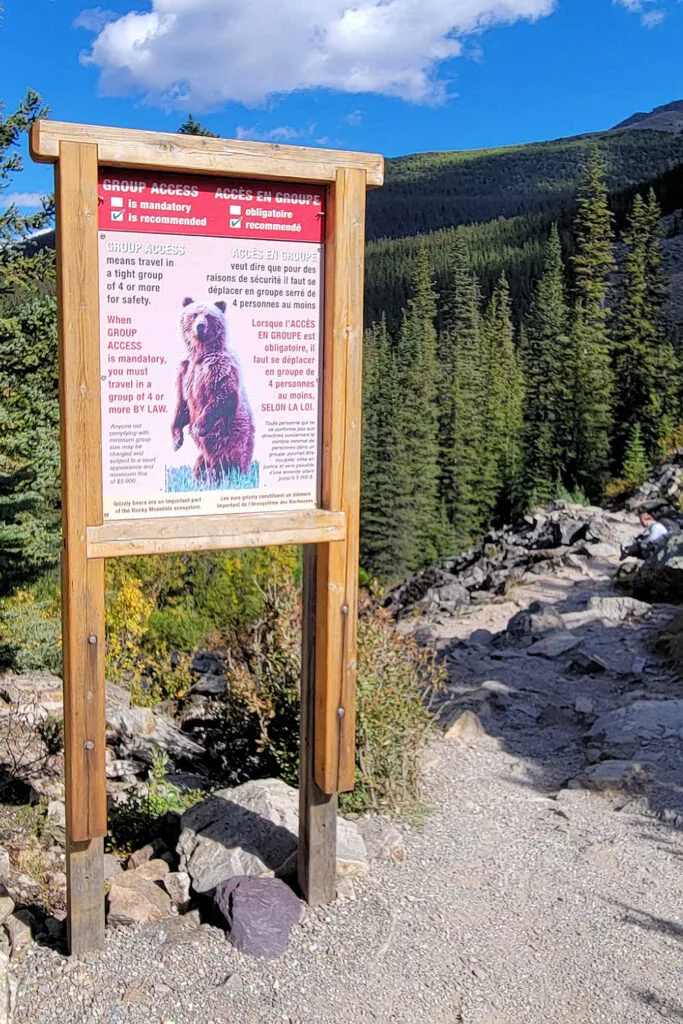
Be aware that in summer, grizzly bears frequent the valley. A sign at the trailhead will indicate whether hiking groups of four or more are recommended or mandatory.
If you want to hike and there are fewer than four people, wait, and join another hiking party to maintain the minimum numbers.
The hike to Consolation Lakes is relatively easy, with little elevation gain. Wearing boots with ankle support will help with boulder climbing.
The trail ends at the first lake, encompassed by a rock pile. You’ll need to negotiate your way over the rocks to continue onto the Second Consolation Lake.
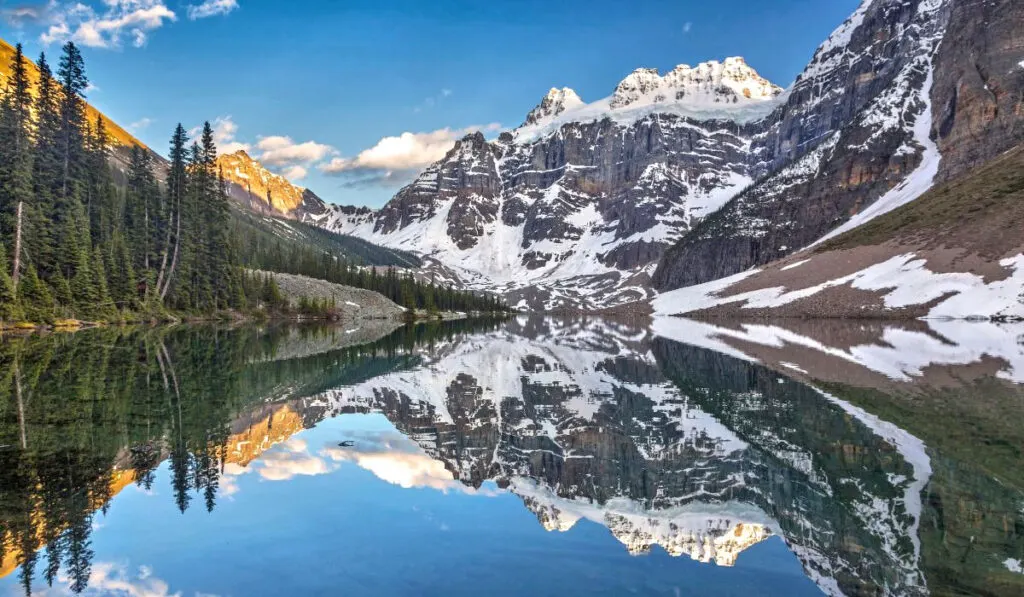
Hoary marmots live in the rock pile; if you wait patiently, you might spot one. On a sunny day, they often lie on the rock, sunning themselves in the heat of the day.
Waterfowl Lakes
- Location: 57 km (35.4 miles) west of the junction
Like the previous lakes, the Upper and lower Waterfowl Lakes are reached on short hikes. The start of the trail begins near the Waterfowl Campground.
Camping there allows you to access the lakes early in the morning to enjoy reflections of Mount Chephren. Later in the day, you won’t see those mirror reflections when the winds pick up.
The trail is short, easy, and suitable for families. Start at the trailhead for Chephren and Cirque Lakes. Once you reach the river, turn left to go to Upper Waterfowl Lake or right to access the lower one.
While you can see the Lower Waterfowl Lake from the highway, the Upper one is the more picturesque of the two. Since the hikes to both are pretty short, I recommend seeing them both.
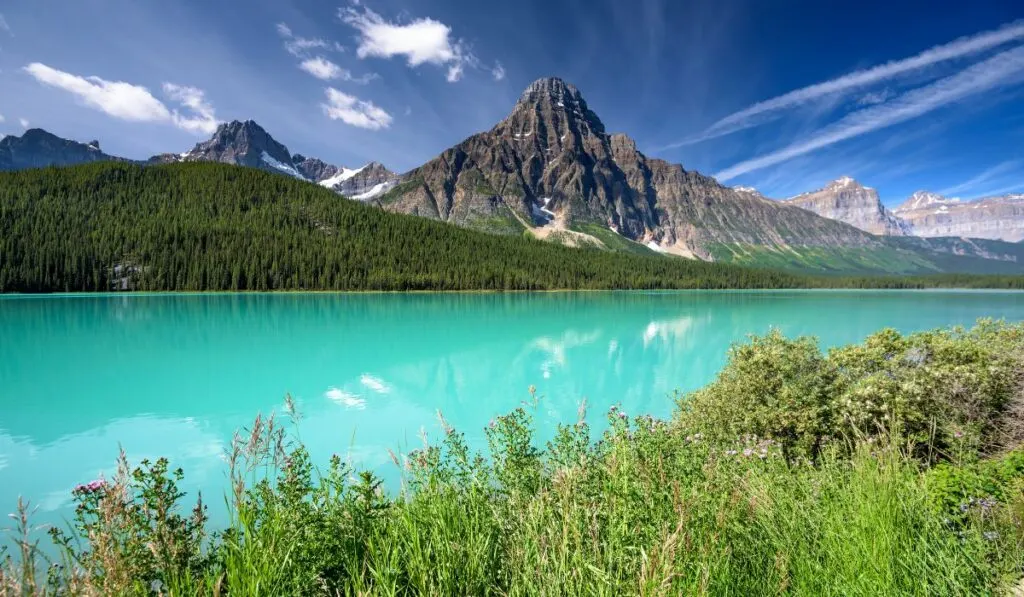
Being close to the campground, expect heavier traffic midday. You can complete this 1 km hike in ½ hour. If you’re ambitious, consider hiking further to Chephren Lake.
At 8 km, this trail has little elevation gain, but it’s considered moderate due to so many tree roots. There’s an incline at the start of the trek, but it levels out quite quickly.
At the beginning and end of the hiking season, expect a lot of mud on the trail too.
Final Thoughts
Taking a trip to Banff National Park is an adventure like none other. Every visitor can’t help but be awe-struck by the park’s immense beauty and abundance of wildlife.
While some of its lakes are world famous, others, unknown, are just as beautiful and worthy of a visit. Expect crowds at the lakes with easy accessibility. If you prefer fewer crowds, plan to visit the ones which require a hike.
I have spent many summers in Banff and continued onto Jasper National Park, exploring the outdoors, viewing the abundance of wildlife, and experiencing the numerous mountainous hikes.
The lakes in the Canadian Rockies are unique in that the rock flour turns those usual blue tones to hues of turquoise and cyan. Even an artist couldn’t paint a more beautiful canvas. And while those pictures on the web look photoshopped, you’re not.
It’s important to note you won’t always see those turquoise hues. The water changes color as the snow melts and puts more rock flour into the lake.
To stay in the parks, you will need a park pass called a Discovery Pass. They can be purchased online or at the park entrance.
Happy travels ~ Karen

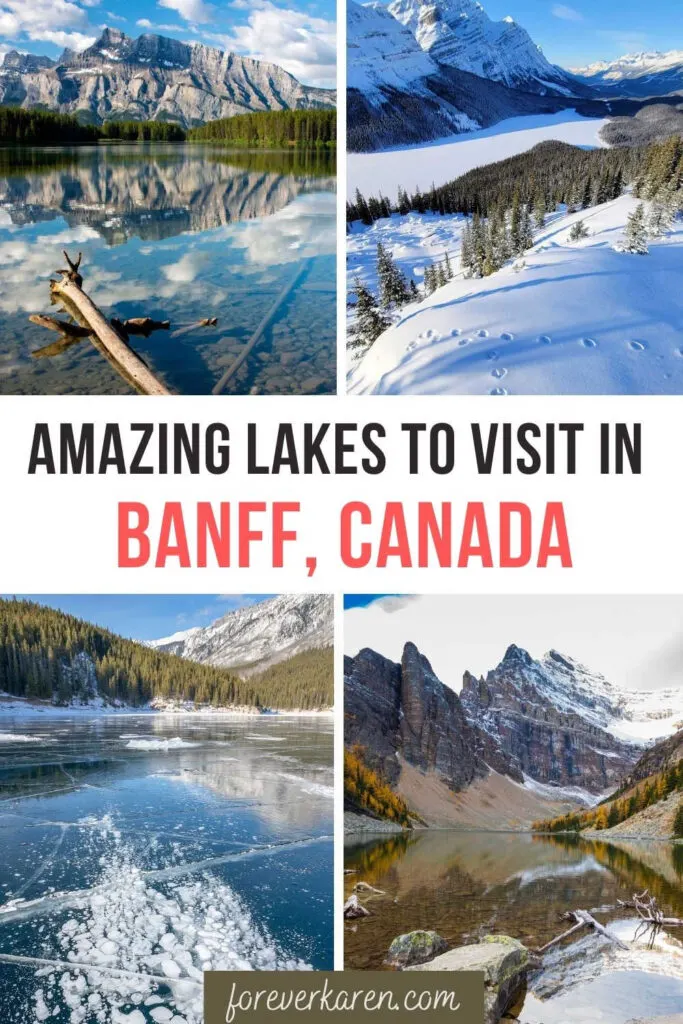
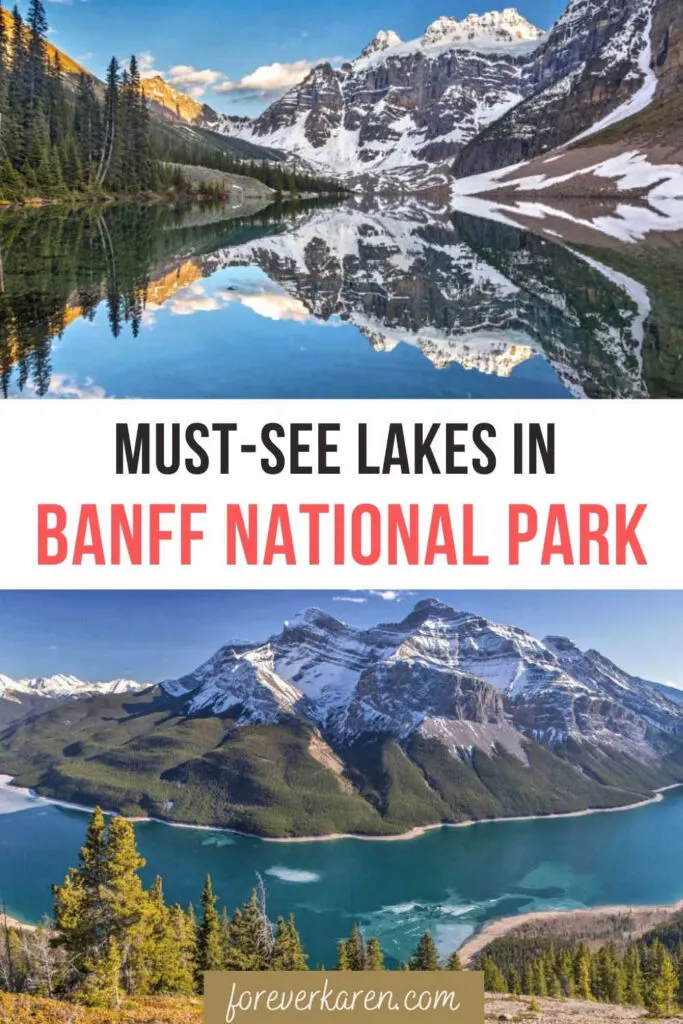
Joseph A. Balderama
Friday 26th of March 2021
While all these lakes are nice and beautiful, you forgot to add moraine lake.
Forever Karen
Friday 26th of March 2021
It's there, after Lake Louise and Lake Agnes. Moraine Lake is a must-visit and so close to Lake Louise, you can't visit one without the other. Besides, Moraine Lake is my favorite with its turquoise waters and surrounding mountains which are a photographer's dream.